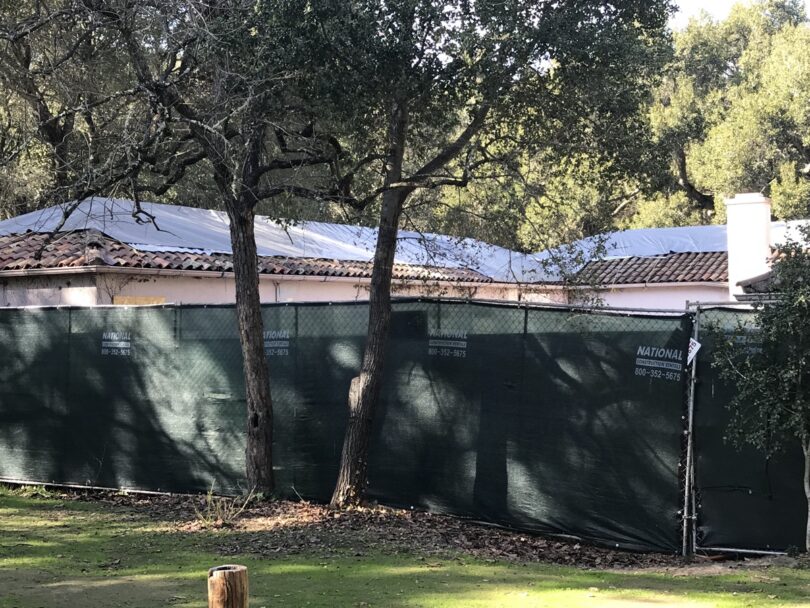Is Halsey House actually locally historic? Maybe. That is if you want a monument to commemorate persons enjoying the privileges of early 20th-century systemic racism and imperialism.
In fall of 2019, we wrote in-depth about the myriad technical issues limiting the future of the Halsey House structure in Redwood Grove – now red-tagged and unused since 2008 . One issue: its “Kalman score” of local historic significance had fallen from 95 to 73 – indicating that if ever it were historically significant in the first place, not enough physical architectural “stuff,” aka significance, is left anymore.
Almost a decade ago THIS Kalman score was supposed to be the deciding factor in the ‘preserve’ it vs. ‘demo it’ council decision.
Our 2019 prior article explains—
it would run $3.5 million to ‘restore’ (The 2015 Sandoval estimate. The History Commission “forgot” to ask ARG in 2019 for new estimates in its $50,000 report!)
it is in the worst possible flood zone AE (risky risky risky. see next image below.)
it is not ADA compliant (expense, expense, expense)
the site will need a new bridge for a fire engine (expense, expense, expense)
it has no parking (neighborhood nuisance parking congestion )
in the 1974 Redwood Grove Master Plan, neighbors were told structure occupancy would be limited to 30, while in 2015 and 2019 reuse plans, occupancy ranges from 90 to 200.

You can locate Halsey house – bottom red circle – with the hiking trail landmark from the Google Earth map above. Hatched area is the creek. Blue is flood zone A that requires special insurance and special construction conditions – elevation of the building on 6 to 12 foot piers. See that Shoup Park Garden House – top red circle – abuts an A zone. Funny how a straight line was drawn exempting the building and the parking lot. A bribe back in day?
See City of Los Altos Parks &Rec Commissioner Pete Dailey’s new Halsey House report with updated costs and risks, as attached to the Feb. 10 P&R meeting packet.
Call to Action
Lalahpolitico: Orange-University neighbors you need to take action – show up and speak – at the 3 upcoming commission meetings where the biased consultant, ARG, will spin a story for commissions. The meetings will be of the History Commission, Parks and Rec Commission, and the Financial Commission. Dates below. And neighbors, you will need to show up at the Council meeting in March where the council will weigh pros, cons, costs, risks, benefits, harms of alternatives: Tear down and landscape vs. Rehabilitate and reuse totally or partially. As neighbors, you are key stakeholders.
Here are the regularly scheduled Commission meetings.
Jan. 25 Historical Commission. Did ARG already present its report to them?
Feb. 10 Parks & Rec Commission
Feb. 15 Financial Commission
Feb. 22 Historical Commission
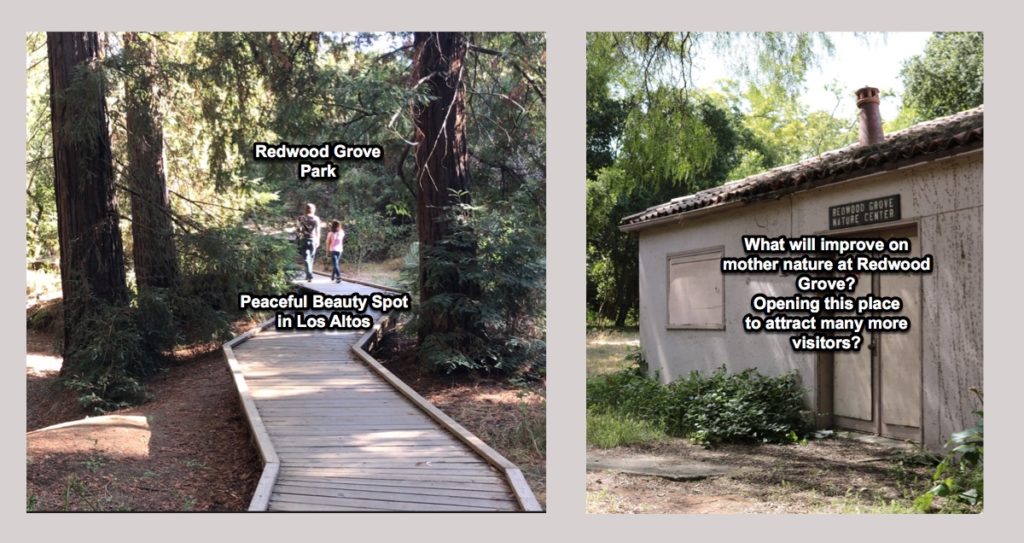
Will “active recreation programming” in a building – namely an estimated $3 to $5M ‘restored’ Halsey House – degrade or improve the Redwood Grove experience? Is it necessary? Donna Legge of the City Rec. Dept says no.
Donna Legge of the Recreation Dept. says she can “program” for whatever is there at Redwood Grove – “We don’t need a building” to do programming such as from providers like Acterra, Hidden Villa etc.,
“We don’t need a building” to do programming such as from providers like Acterra, Hidden Villa – Legge of Parks&Rec Sept.
So in this article we take a harsh look at the “historical significance” of Halsey House. We take NO pleasure in doing this.
A structure can have significance by
1) being a good example, or a scarce example of some historic style
AND/OR 2) because persons of historical significance lived there
In our 2019 article, it was explained that the University-Orange neighborhood has plenty of privately owned and maintained MUCH BETTER examples of the Spanish colonial / eclectic/ Monterey architectural style AND that Los Altos born, local architect Abbey Ahrens has been building new homes in that style since the 1990s. Just drive around in the Orange-University area and you’ll see many old ones and new ones. See if you can spot the new ones!
Persons of Historical Significance?
Hmmmmm?
William Hanford Wright was one of 9 children of the Los Gatos orchard-owning Wright family. Around 1900 William — whose first business was President of was the San Jose Fruit Packing company — moved to San Francisco with his school teacher wife Myra. Why? In 1899, 11 of the state’s biggest canners had merged under the name California Fruit Canners Association (CFCA), so by 1900 Mr. Wright needed a new career path. [It took many more years of mergers and acquisitions till Calpac/DelMonte emerged as the winner of the canning market!]
From his new location in San Francisco, William Hanford Wright owned and operated a bay dredging company. Around 1912, William asked his daughter Emma – then about 32 years old – to drive down the Peninsula to find a summer retreat, “a place in the sunshine with a creek and some redwoods.” She did. William and his wife purchased the six-acre Los Altos property that included a “small, two-bedroom summer cottage” and “one small redwood” and some sickly willows. Until 1923, the family used the property only as a summer retreat.
Read a bit about Bay Area dredging from KQED
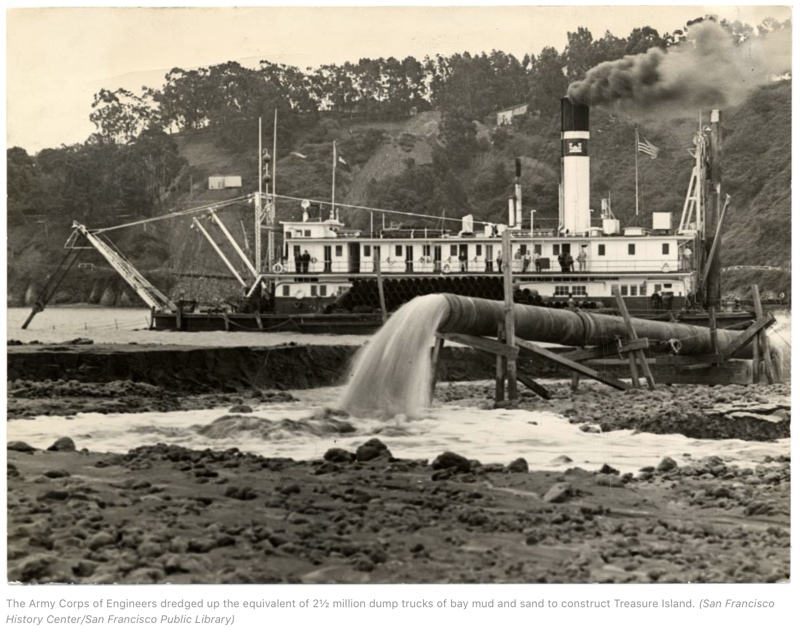
It sure seemed like good idea in the early 20th century to do all that dredging in the San Francisco Bay area. See the KQED article for a map of all the south bay marshland that was filled in!
Lalahpolitico: I see nothing extraordinary in this family history so far. Do you? Younger children like William Wright who weren’t going to inherit the farms/orchards needed to strike out on their own. The fledgling canning industry was full of start-ups, almost all of which disappeared in acquisitions. In those days it was common practice to dredge in the bay to keep the channels to the ‘ports’ like Redwood City and Alviso open for business.
In recent decades we have realized dedging was bad for the SF Bay ecosystem and for bayshore flood resiliency. Who wants to be remembered for harming the environment? Or remembered for being one of first fruit canners to “be merged and acquired”?
In 1915, William’s daughter, Emma Wright married Theodore Vail Halsey under an oak tree at the Los Altos summer retreat cottage. The couple continued to live with Emma’s parents in San Francisco till 1923. Emma bore two children in SF, Theodore Jr. 1917 and Myra 1919. The young couple and their children moved to a newly constructed Los Altos house in 1923. At some point thereafter, they tore does down the original cottage on the 6 acres.
The groom Theodore Vail Halsey and his famous uncle
Who was Emma’s groom, Theodore Vail Halsey? His mother (Vail) had successful relatives. In particular one Theodore Newton Vail, was his mother’s brother – twice the President of ATT, once between 1885 and 1889 and again between 1907 to 1919. During T.N. Vail’s first “retirement” after 1889, he traveled extensively to Latin American, evangelizing and introducing modern technologies. During his second stint as President of ATT, he is credited with bringing the US industry to “a more open system of interconnection” and for the ATT national monopoly that lasted for 70 years till 1984. “One policy, One system, Universal Service.”

The uncle – twice and ATT President – who may have smoothed the way for his nephew Theodore Vail Halsey to enter the telecom business?
Lalahpolitico: Well that particular president of ATT definitely is HISTORICALLY SIGNIFICANT. Wow, a monopoly to his credit. Too bad that famous uncle never visited Los Altos.
Back to Emma’s groom, Theodore.
Since at least as early as 1906, the groom T.V. Halsey was employed at Pacific Telephone and Telegraph Company (PTTC) in San Francisco. The company would eventually become part of the national AT&T system.
Lalah: Perhaps the maternal Vail family, namely his UNCLE, President of American Telephone and Telegraph, helped get him that job as “political agent” at PTTC reporting to the Vice-President Louis Glass at PTTC. [Uncle Theodore was President of ATT 1907 to 1919.]
In his role as “political agent’ at PTTC, reporting to VP Louis Glass, the young Theodore became involved with corrupt city dealings like bribery, was charged, repeatedly never appeared in court, but by 1912 indictments were dropped. His boss, VP Glass, was convicted in 1907 but the state supreme court overturned the convictions in 1910.
Lalah: Was this bribery scandal just a peccadillo or a modus operandi for how the two of them were doing business with governments, domestic and foreign?
For the years 1915 to 1923 Halsey apparently resided in SF with Emma and her parents on Russian Hill. He had no commute. [Except maybe to the Philippines?] In 1923 he and Emma moved into the Los Altos Spanish eclectic style house. How did he commute to SF then? Perhaps he caught the Inter Urban train at the Los Altos station, took it to California Street to catch the Southern Pacific to San Francisco every workday as an ‘executive officer’ – ‘political agent’ at Pacific Telephone and Telegraph. Or perhaps he drove.
The City of Los Altos consultant ARG historian says in its Halsey House 2019 report for the City, that the groom Theodore Vail Halsey was the FIRST President of the Philippine Long Distance Telephone (PLDT) company. TRUE. So do other sources. The ARG historian indicates this presidency was AFTER the 1915 wedding– apparently a long time after! Actually, that job title did not get conferred on Theodore till 1928 when the PLDT company was formed – after many mergers & acquisitions and a monopoly deal with the local government was struck!
The ARG historian also says Theodore was playing “a significant role in the introduction and development of telephone systems in the Philippine islands since 1906.”
At a date uncertain, Louis Glass was the the President of the Philippines Telegraph & Telephone Company (PTTC), while Theodore Vail Halsey was VP. In 1924 when Glass died, Halsey became President of PTTC. Note that PTTC has a small part of what would become – through many government-approved mergers and acquisitions – the 1928 Philipines Long Distance Telephone (PLDT).
So apparently ‘being involved since 1906 with Philippine telegraph and telephone infrastructure’ was a job Theodore could do across the ocean from San Francisco? [ARG report]. He married Emma in 1915. The City of Los Altos paid historians at ARG write as though he continuously lived on Green Street on Russian Hill in his wife’s parents’ house there from 1915 to 1923. Did he have to travel to the Philippines at all? Ever? A slow boat? The business records suggest he was “involved” with the Philippines from 1906 to 1928 and perhaps till 1930.
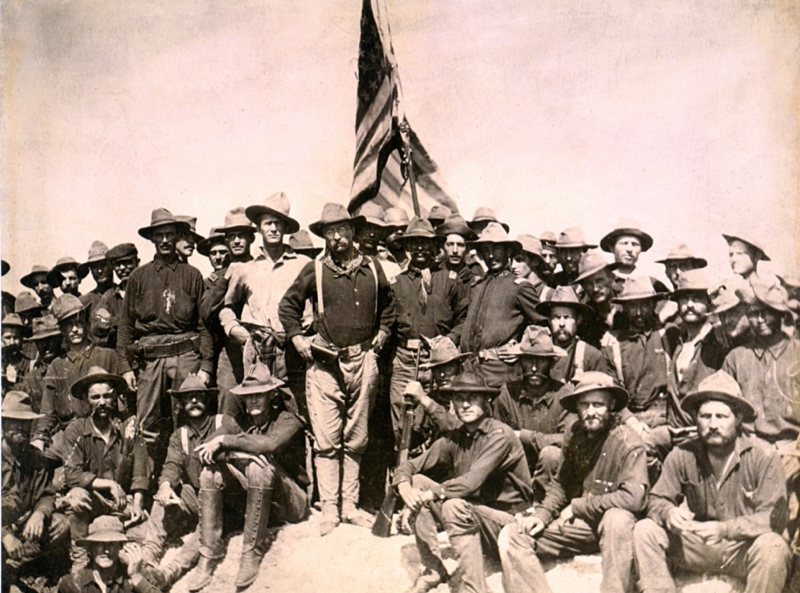
An unintended (?) consequence of Teddy Roosevelt’s Spanish American War was the USA’s embarking on the path of imperialism and dominion over ‘other’ peoples – one ‘colony’ was the Philippine archipelago.
What happened around 1906 in the Philippines?
What was T.V. Halsey’s role in the islands in those times?
He was a complicit tool of America’s sorry escapade as a racist imperialist colonizer. – Lalahpolitico
Say What? You may recall Theodore Roosevelt’s Spanish American War of 1898, incited in part by Hearst papers hysterical coverage of the alleged bombing and sinking of the USS Maine in Havana harbor by Spanish terrorists. {Later research determined it was an accidental explosion due to a faulty onboard system.}
So Roosevelt went to war in Cuba and the USA “won” all the Spanish colonies in the Western hemisphere and the Pacific!
Meanwhile in the Philippines, after centuries of Spanish rule, Spain was in the process of granting some independence to the locals. The arrival of the US military after 1898-9 stopped all that. The archipelago was deemed not ready for independence and instead, there would be a “Benevolent Assimilation.”
The ensuing 10 year war with the independence fighters started as a conventional war but developed into a guerilla war. It got really ugly and really racist. Trigger warning – if you are sensitive to words as violence, skip the bullets below.
- US. troops took to calling the Philippine insurgents “nxxxxxs…”
- They also called them “gu-gu” or “goo-goo”…”almost certainly the linguistic ancestor of “gxxx.” [rhymes with kook]
- They administered the “water cure” to prisoners, a little like waterboarding but also killing the prisoner
- US. soldiers wrote letters home saying the guerilla-style war was like “hunting. It makes me think of jack rabbits,” OR
- “…we just shot the nxxxxxs like a hunter would rabbits.”
Source: Race-making and Colonial Violence in the U.S. Empire by Paul A Kramer, Oxford University Press. See Sources at the end for a link.
T.V. Halsey and Philippine Telecommunications after 1906
It’s not like the archipelago had no telecommunications when the US troops arrived in 1898-9. It had telegraph lines, some localized telephone services and even a couple of undersea cables to the Hong Kong mainland installed by non-American equipment companies. Some of these were privately owned communications network companies, others were 40-year concessions to the British and Chinese companies.
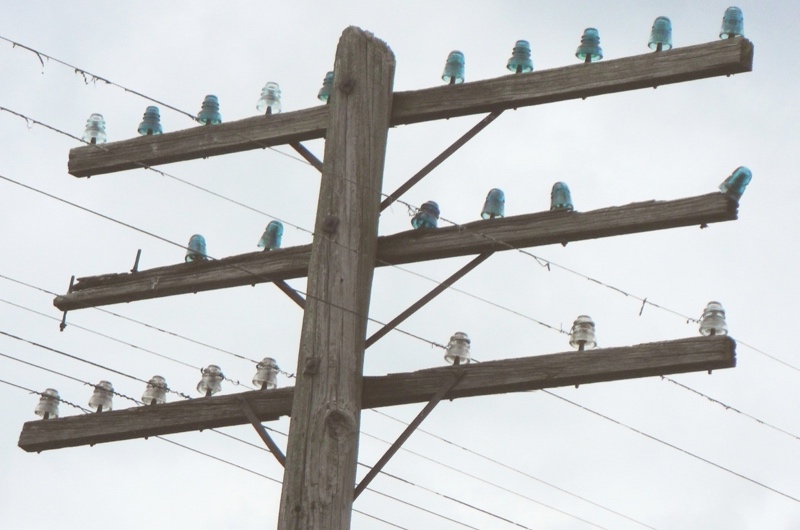
The US military occupation forces in 1898-1899 removed the existing Philippine telecom lines or converted them for military use.
1898 Full US Military Control of Telecoms
At the beginning of the American-Philippine war, when the US military occupied a province or a region, it actually might take down existing service. “Americans put up their own telegraph and fewer telephone networks. Initially, all were used exclusively for military purposes.”
1902 Constabulary – Quasi Military Control of Telecoms
In 1902 the Constabulary was formed, but this was also martial law. There was a telegraphy division reporting directly to the Constabulary.
Lalah: The Constabulary was not much different than the telegraphy run by the US military? Given the ongoing guerilla insurgency, one can see the importance to the US military/colonialists of cutting off freedom fighters from the telecommunications systems. No wonder the fighting style moved from conventional war to guerilla warfare!! Guerillas communicate by word of mouth!
1906 Bureau of Posts – Quasi Civilian Control of Telecoms
In 1906 all the communications lines of the Constabulary were transferred to the Bureau of Posts in accordance with a law that reorganized the Insular Government, removing full martial law.
The gradual transfer of the military telegraph and telephone lines and offices to the more civilian Bureau of Posts continued up to 1910. Following the transfer, the Bureau of Posts converted most of the telephone lines into telegraph circuits. Those which were not converted into telegraph were turned over to certain provincial governments which continued their operation as provincial telephone systems. On June 30, 1911 the telegraph division of the Bureau of Posts no longer operated any telephone circuit. (Those phone circuits were controlled by provincial jurisdiction)
Lalah: Why the mass conversion from telephone to telegraph lines? Ah,ha, telegraphing allows very tight ‘surveillance’ of message senders and receivers!?
It is clear that the civilian Theodore Vail Halsey first got ‘involved with the Phillipines telecoms during this 1906’ gradual handover of telegraphy operations and communications lines from the military to the ‘civilian’ Bureau of Posts.
As noted above, the City of Los Altos ARG Historical 2019 report has a footnote suggesting T.V.Halsey was “involved in the islands telecom since 1906”. He and his corrupt boss, Louis Glass, were named President and VP of Philippine Telephone and Telegraph Company.
Halsey and Glass aided and abetted the continued US rule of the archipelago. He likely formed a number of city and provincial sized telecom companies – US owned – and orchestrated mergers and acquisitions over the years. General Telephone and Electric, ATT’s biggest rival in the US, was probably also active in exploiting the Phillipine ‘colonial’ opportunity. The end of colonialism, aka independence of the Phillipines from the US, did not occur till after WWII in 1946. T.V. Halsey named was the First President of the 1928 telecom monopoly – the Philippine Long Distance Telephone. PLDT, and the preponderance of the country’s other telecom companies were US owned until 1967!!!
Regulated monopoly profits flowing to the US! Built on the blood and bones of the victims of the American-Philippine War. Yeah, that’s “Benevolent Assimilation.”
VERDICT: GUILTY OF COMPLICITY & COLLABORATION IN COLONIAL EXPLOITATION
The bride Emma Wright Halsey
Her significance seems to ride on the fact that she took steps to have redwood tree saplings planted along Adobe Creek on some parts of her six acre Los Altos parcel. And that she allegedly drove a truck to accomplish this.
Former Mayor Megan Satterlee famously mocked the family’s significance. https://www.dailydemocrat.com/2015/12/09/los-altos-halsey-house-faces-uncertain-future/
This redwoods planting occurred after 1923 when Emma and Theodore decided to live year-round in their new Spanish Eclectic House. But her first project according to the Sandoval report 2015 is that she and her gardener started planting extensive flower gardens. These seem to have been within the house courtyard at first.
She had acquired a Japanese gardener – Omori, apparently a bachelor – who may have been there full time? And may have lived on the premises? Or near the premises? [Lalah saw in the 1990s with her own eyes, that there used to be three small, rickety ‘shacks’ on the parcel up till the. At that time they were rented out as artist workspaces without utilities. Were they ever used as housing in the distant past? Outhouses and lack of indoor plumbing were not uncommon in the 20’s and 30’s.
In the 1920’s thru the 1990’s, the University – Orange neighborhood used to have some very modest apartments and bungalows intermixed with the rich people’s homes! Diverse housing! Now torn down, Gone!
Omori? Did he have a full name? Say his name. During the 1920’s he decided to return to Japan, but not before recommending the Hongo family as his replacement.
In the 1930 Census, the Hongo family is reported at the same address as Emma Halsey. Was he the only the person from his family who was working for her on her 6 acres, or were more of the family also working for her?
In 1942 the Hongo family was sent to internment in Wyoming. In 1943 Emma’s husband passed away. And it must have been difficult to hire yard help during WWII to tend the 6 acres parcel in the way she was accustomed. By 1945, she had succeeded in selling the property for $25,000 and moved to Palo Alto.
All these oral accounts are based on stories Emma’s granddaughter heard when young. Ms. Bussey said she did not visit the house between 1945 and 1974 (when the city acquired the parcel).
The oral lore of the redwoods planting

Excerpt from the City paid consultant report ARG 2019. Notice that Omori is the one holding two heavy looking buckets. Emma is not dressed for gardening. Those dainty shoes. Her apron is so clean. She holds nothing. Omari’s pants are soiled from the garden.
The image of Emma evoked by the granddaughter’s recollection which you can hear on this Youtube video…
a plucky Rosie the Riveter type,
a woman who CAN DO,
driving a truck ( manual transmission) up and down the 1920’s bad roads,
reaching Summit Road, Santa Cruz Mountains,
wielding a shovel in order to toe-out those Redwood saplings,
tossing them in the truck,
driving back to Los Altos,
ripping out those Creekside dead willows and all the tangle of dead roots,
again with a shovel in hand, slipping those baby redwoods into the damp earth.
Inspiring but is that likely the reality? Look at the photo of Omori and Emma above. He is holding two pails that look full and heavy. She holds nothing. We can’t see her hands to see how soft they are.
Lalah thinks this woman made some excellent floral arrangements from the flowers in her garden. We have seen 1920s – 1930s pictures of the house interior with lovely, lavish floral arrangements.
But can you believe Emma did any of the heaving lifting on the care of the 6 acres? Willow tree and root removal work? Tree Planting?
Surely, she organized and supervised it, but don’t you think Omori was the doer? She just said, “Dig out that one, dig out this one.” “Plant one here, put one there, oh no, maybe over there instead.”
Emma’s redwood planting project, maintenance of extensive gardens, keeping after the 6 acres all year long — was impossible without the exploitation of abundant cheap immigrant labor!!
Notice that when Emma’s cheap labor supply vanished – the Japanese internment of the Hongo family plus the WWII draft of white and black able-bodied men – there was no way for her to continue with the back-breaking gardening maintenance. She sold the property by 1945.
VERDICT: GUILTY OF SYSTEMIC WHITE SUPREMACIST EXPLOITATION OF JAPANESE IMMIGRANTS
Lalahpolitico Bottom Line:
Dear Commissioners – Historical, Parks&Rec, Financial – and Council Members, if you decide to recommend restoring the house in full or in part, in spite of the overwhelming financial, climate and neighborhood quality of life reasons to demolish it, please change the structure’s name to the Omori-Hongo House.
If you wish to restore the Halsey Hubris House, please change its name to the Omori-Hongo House
The grandchildren of the people discussed in the article have had their family privacy wantonly exploited by a small group of zealots at the “Friends of Redwood Grove”. The group has deviously misnamed themselves and should call themselves what they really are – Friends of Halsey House.
And it’s been 40 years since the structure was designated locally historical. Under today’s more enlightened way of looking at history – namely with an anti-racist & anti-imperialist lens – this house’s local historical designation should be CANCELLED.
In Germany, there is a privacy law called ‘The Right to Forget’. Let’s forget this local Halsey history, much like we choose to forget our local ice-pick lobotomy doctor.
Jan 2021 photos of Halsey House –
The city has recently installed chainlink fencing and tarp over much of the roof.

Was it ever true or is it now true the architecture or the persons are locally historic? Pic from 2015 Sandoval report.
Key Resources:
For more on the flood risks of City assets, Shoup Park’s Garden House and the Redwood Grove’s Halsey House see section 2 – “No flooding protection included” of our 2019 Storm Drain article.
2015 Here’s the Sandoval Report.
2019 Here’s the ~150 page City/ARG report.
See City of Los Altos Parks &Rec Commissioner Pete Dailey’s new Halsey House report with updated costs and risks, as attached to the Feb. 10 P&R meeting packet.
Friends of Redwood Grove web page
Not every name on the Friends page is a supporter of their current advocacy for partial or full restoration of the Halsey House structure.
Unverified: There is a new donor to the Friends, a resident of Los Altos Hills, who wants the Eucalyptus trees in the nature preserve removed. His donation money was explicitly for the purpose of preparing landscape designs for the six acres. It is unclear if the donation assumes the removal or restoration of the house. Apparently, only a few city staff have seen the designs.
Race-Making and Colonial Violence in the U.S. Empire: The Philippine-American War as Race War
Race-Making and Colonial Violence in the U.S. Empire: The Philippine-American War as Race War, Paul A Kramer, Oxford University Press
Other indignities in US-Philippine relations during US imperialism:
Philippines residents were technically US citizens and thousands fought in WWII. Those surviving WII vets get NO vet benefits.
As nominal US citizens, Philippinos were not subject to internment during WWII, like the Japanese Americans were, but could emigrate and get low-wage grunt work.
More Resources we used:
Google book about rampant bribery in City of San Francisco 1900’s to secure city contracts.
Employed as a “political agent” by Pacific States Telephone and Telegraph, Theodore Vail Halsey “had made the direct and observable bribery payments to the [City of SF} supervisors in the bare rooms in the Mills Building.” He was scheduled to go to trial in 1907 but proceedings were repeatedly postponed. In 1907, Halsey’s boss, Louis Glass, VP of Pacific States Telephone and Telegraphy (PSTT), was convicted and sentenced that summer. Glass appealed and three years later the state supreme court nullified his conviction. In 1912 “remaining indictments” against the two men were dismissed.
Regarding the Philippines, Glass was president of the Phillippine Telephone and Telegraphy Company (PTTC), and Halsey VP, ascended to President of PTTC upon Glass’s death in 1924.
In 1906, just as Halsey was starting to “be involved in telecommunications” in the Philippines, Theodore Vail Halsey was a ‘political agent” reporting to his boss, Louis Glass, VP and general manager of Pacific State Telephone and Telegraph Company in (PSTT) San Francisco. Not too long after, Glass became President of PTTC, and Halsey VP, apparently without setting foot in the Philippines?
Collected Excerpts
“When PLDT was incorporated and given the franchise to establish and operate telephone services in the country on November 28, 1928, a typhoon had just ravaged Eastern Visayas, Bicol Peninsula, and Samar.
The first president of PLDT was Theodore Vail Halsey, while Major J.E. Hamilton Stevenot, who represented the American firm General Telephone and Electronics Corp. (GTE), was elected executive vice president and general manager.
Under the American owners of PLDT, many small phone companies in the provinces were acquired by the Company to help speed up the rollout and connection of these different phone systems all over the country. The management of PLDT was then set to lay the groundwork towards linking Filipinos to each other and, more importantly, to the world.
….
– The Philippine Islands Telephone and Telegraph Company (PITTC) is American-owned which started operations in 1905 in Metro Manila. In 1928, it merged with Cebu, Panay, and Negros Telephone and Telegraph companies to form the Philippine Long Distance Telephone Company (PLDT).
– In 1932, the colonial Philippines congress granted PLDT a 50-year franchise to operate a national telephone system. The establishment of the Public Service Commission to regulate the industry as well as other utilities, meanwhile the Bureau of Posts was created to operate telegraph services nationwide.
– In 1967, the company PLDT was sold to Philippine nationals.
– Metro Manila had phone services since 1905.”
https://www.scribd.com/document/211155028/History-of-the-Philippine-Telecommunications-Industry
Register at scribd.com with an email and you can read 100 articles a month for free.
In 1922, PLTTC [typo should be PITTC?] was dissolved and its assets and business taken over by another company, the Philippine Telephone and Telegraph Corporation (PTTC). [Lalah: We know that Glass and Halsey became President and VP respectively of PTTC]
http://www.onlinebiographies.info/ca/sf/halsey-tv.htm
1931 bio page of Theodore Vail Halsey. Los Altos Masonic Temple…Telephone Investment Corporation. Telephone Pioneers of America. “Prior to Jan. 1, 1930 an executive officer of Pacific Telephone and Telegraph Company.”
Lalah does this imply he left the firm?
https://en.wikipedia.org/wiki/History_of_the_Philippines_(1898–1946)
https://en.wikipedia.org/wiki/Telecommunications_in_the_Philippines#Colonial_period
https://edge.pse.com.ph/companyInformation/form.do?cmpy_id=6
PLDT – Theodore Halsey first President – totally under US ownership till 1967
“PLDT Inc. (TEL), formerly Philippine Long Distance Telephone Company, was incorporated on November 28, 1928 following the merger of four telephone companies under US ownership. … In 1967, effective control of TEL was sold by General Telephone and Electronics Corporation to a group of Filipino businessmen. Over the period 1998 to 2011, Philippine Telecommunications Investment Corporation, Metro Pacific Resources Inc. (both of which are Philippine affiliates of First Pacific Company), NTT DOCOMO, INC., NTT Communications Corporation, and JG Summit Group acquired significant ownership of the common shares of TEL. On July 29, 2016, the Securities and Exchange Commission approved the change in corporate name to the present one.”
Early Canning industry history
https://www.waymarking.com/waymarks/WMNPPA_Del_Monte_Packing_Plant_History_San_Jose_CA

